2. 中国科学院大学, 北京 100049;
3. 陕西省气象科学研究所, 西安 710014
2. University of Chinese Academy of Sciences, Beijing 100049, China;
3. Meteorological Institute of Shaanxi Province, Xi'an 710014, China
随着社会经济的迅速发展, 城市化和工业化加剧, 大气污染已成为21世纪我国民众面临的最大环境问题之一.细颗粒物(动力学当量直径小于2.5 μm的颗粒物, 即PM2.5)是造成大气环境污染的重要贡献因子, 能够显著降低大气能见度, 对人体健康产生危害, 且对全球及区域气候具有显著影响[1, 2].无机离子是大气细颗粒物的重要组分, 其化学组成直接决定了大气气溶胶的酸碱性和吸湿能力, 从而影响颗粒物中二次无机和有机气溶胶的化学演化, 并能改变气溶胶的光学性质、造成灰霾等大气污染事件.
目前, 国内外在城市地表地区对颗粒物中的无机离子等的研究已经比较广泛, 包括了无机离子的特征及来源分析[3~5]、季节变化[6~8]、粒径分布[9~12], 以及对大气酸度的影响[13~15]等.高山地区由于温度低, 海拔高, 以及强太阳辐射等特点, 造就了其独特的大气环境.高山地区对流层气溶胶主要来自长距离运输, 因此能够代表大尺度范围的大气特征[16].此外, 高山地区海拔高, 接近边界层, 气溶胶能直接作为云凝结核(cloud condensation nuclear, CCN), 影响云的形成与演化, 从而影响气候[17], 因此高山地区气溶胶组成的研究对探讨我国大气污染状况及环境、气候效应具有更加重要的意义.
国内外学者在高山地区大气污染研究方面已经取得一定成果.例如Rosenfeld等[18]对比了西安市及华山西峰顶近50多年的大气能见度、降雨以及相对湿度等气象数据, 证实日趋严重的大气污染导致了我国内陆山区降雨量的减少.李建军[19]分析了冬夏两季华山大气PM10的无机离子组成, 发现华山冬夏季二次离子的主要存在形式为NH4HSO4及NH4NO3, 而(NH4)2SO4的含量较低.苏彬彬等[20]对华东背景点武夷山, PM2.5及PM2.5~10中无机离子变化特征进行分析, 发现硫酸盐主要存在于细颗粒物中, 且主要以(NH4)2SO4和K2SO4的形式存在.文彬等[21]在长江三角洲背景点黄山, 对不同海拔高度大气气溶胶不同粒径段的无机离子组分进行研究, 其结果显示大气气溶胶无机离子成分随高度的增加呈递减趋势, 且NH4+和SO42-这两种离子主要结合成(NH4)2SO4和少量的NH4HSO4存在于颗粒物中.尽管如此, 当前国内外针对大气气溶胶理化性质的垂直分布特征研究相对较少, 仅有的少量研究多为飞机观测或铁塔观测, 存在时间较短或垂直高度较低等问题[15, 21, 22].
关中平原作为以热力发电为主要经济产业的地区, 是我国气溶胶污染最为严重的区域之一.有研究表明关中平原受到了燃煤排放以及不利气象条件的双重影响[23, 24], 导致其相比国内其它地区, 冬夏季的大气污染均十分严重.此外, 东亚沙尘传输和生物质秸秆燃烧对关中大气环境也有显著影响[25].华山具有海拔高、山势陡峭、直面关中平原和紧邻关中盆地人为污染源等特点, 是研究大气污染垂直分布的理想场所[16, 24, 25].本文以华山地区大气为研究对象, 同步观测华山山腰及山脚大气PM2.5中无机离子的组成和分布, 探讨关中地区气溶胶化学组分的垂直分布和传输演化等特征, 以期为全面理解关中地区大气气溶胶污染状况及其环境效应提供科学依据.
1 材料与方法 1.1 采样地点观测站点分为山腰点和山脚点.山腰点设在华山西峰的半山腰处, 东经110°3′, 北纬34°29′, 海拔高度为1 120 m.采样点处于山腰的山谷之中, 周边视野开阔, 且周围无明显大气污染源, 基本能客观反映关中高山背景区域的空气质量状况.山脚点设在华山山脚附近的华山气象局, 东经110°5′, 北纬34°32′, 海拔高度398 m, 两个站点高程相差约700 m, 水平距离约为8 000 m(图 1).
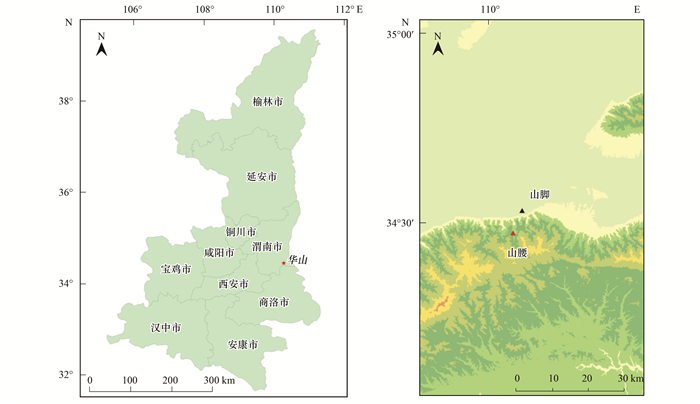
|
图 1 华山山腰及山脚采样点 Fig. 1 Sampling sites on the mountainside and at the foot of Mt. Huashan |
应用TISCH的TE6070DV-BL型号大流量采样器(1.13 m3·min-1)于2016年8月27日至9月17日在山腰及山脚观测站点同步收集PM2.5样品, 每4 h采集一个样品.观测期间高山及山脚分别共采集122和125个样品.所有样品均采用石英纤维滤膜(Whatman QM/A)收集.滤膜使用之前于马弗炉中450℃灼烧6 h以去除可能存在的有机污染物.采样后滤膜保存于-4℃冰箱中待分析, 运输过程中用含干燥剂的封口袋密封, 防止样品中物质的挥发和污染.
1.3 无机离子分析无机离子采用(Dionex)DX-600型离子色谱仪进行分析.首先剪取一定面积滤膜, 加入10 mL超纯水(R>18.2 MΩ·cm), 超声4次, 每次15 min, 随后经脱色摇床振荡1 h后静置.萃取后水溶液用一次性针管和0.45 μm水系过滤器(德国MEMBRANA公司生产)过滤, 于-4℃冰箱中保存, 直至上机分析.
无机离子测试时采用国家有色金属及电子材料分析测试中心生产的国家标准样品配制标样, 检测实际样品浓度.每测试10个样品后进行一次复检, 复检方法为任意挑选1个样品进行重复检测.复检样品浓度为0.03~0.1μg·mL-1时, 两次监测相对标准偏差应 < ±30%;样品浓度在0.1~0.15μg·mL-1之间时相对标准偏差应 < ±20%;样品溶液浓度>0.15 μg·mL-1时相对标准偏差应在±10%以内.
1.4 PM2.5酸度计算本研究采用ISORROPIAⅡ热力学模型计算PM2.5的酸度, 模型选用“forward”模式, 结合实际环境相对湿度和温度数据, 计算“Na+-K+-Ca2+-Mg2+-NH4+-SO42--NO3--Cl-”气溶胶体系的平衡组成和液相水含量[26, 27].气溶胶实际pH值的计算公式如式(1)所示:

|
(1) |
式中, Hair+(μg·m-3)是单位体积空气中颗粒水合氢离子浓度, AWC(μg·m-3)是气溶胶含水量, 均由ISORROPIAⅡ模式计算得出.
2 结果与讨论 2.1 PM2.5质量浓度图 2是观测期间华山山腰及山脚PM2.5质量浓度与气象参数变化情况.整个采样期间, 华山山腰及山脚的PM2.5质量浓度均值分别为(46.9±38.2) μg·m-3和(76.0±44.3) μg·m-3, 山脚比山腰高出60%, 其中山脚略高于国家空气质量二级标准(GB 3095-2012, 75 μg·m-3).在整个22d采样时期, 华山山腰和山脚PM2.5浓度各有2d和9d超过国家二级标准, 超标率分别为9%和41%.地表人为活动更加频繁, 受工业排放、机动车尾气及居民生活排放的影响更加显著, 因此其空气污染较高山严重.此外, 通过山腰和山脚气象参数的比较, 可以看到山腰的平均风速(3.2 m·s-1)远远大于山脚的平均风速(1.3 m·s-1)[图 2(a)和2(d)], 说明山腰的大气湍流显著, 更利于污染物的扩散.采样期间山腰的平均能见度(22.2 km)也明显优于山脚(14.1 km)[图 2(c)和2(f)], 进一步表明高山地区空气质量更好.

|
图 2 华山山腰及山脚气象参数与PM2.5质量浓度时间序列变化 Fig. 2 Temporal variations of the meteorological parameters and PM2.5 concentrations on the mountainside and at the foot side of Mt. Huashan |
从PM2.5质量浓度的时间变化[图 2(c)和2(f)]可以看出, 整个采样时期山腰与山脚的变化趋势基本一致, 且9月12日至9月17日出现较为明显的污染事件.相比我国其他高山地区, 华山山腰PM2.5浓度水平高于2013年夏季庐山的PM10(28 μg·m-3)[28], 以及2012年夏季黄山的PM2.5(21.3 μg·m-3)[29], 接近2007年夏季泰山的PM2.5(59.3 μg·m-3)[30], 说明关中地区和华北地区区域大气污染问题更加严峻.
2.2 无机离子组成华山山腰及山脚PM2.5中无机离子浓度如表 1所示.与PM2.5质量浓度的垂直分布特征类似, 山腰及山脚PM2.5中无机离子的总浓度分别为18.6 μg·m-3和24.0 μg·m-3, 山脚比山腰高出约出30%.由图 3可知两地PM2.5中各阳离子的浓度大小依次为NH4+>Ca2+>Na+>K+>Mg2+, 阴离子浓度大小依次为SO42->NO3->Cl-.其中, SO42-、NO3-和NH4+(sulfate, nitrate, ammonium, SNA)为两地PM2.5中最主要的无机离子, 分别占山腰和山脚点总离子的89%和85%.与山腰相比, 山脚观测点大气中存在较高的金属离子, 例如Ca2+, 其山腰和山脚的质量浓度分别为0.9 μg·m-3和2.5 μg·m-3, 山脚浓度是山腰的2.8倍, 这与Li等[29]研究的黄山夏季高海拔地区Ca2+浓度远低于低海拔地区的结果相一致.这说明近地面地区受地表粉尘的影响更大.
|
|
表 1 华山山腰及山脚PM2.5中无机离子及pH统计汇总/μg·m-3 Table 1 Inorganic ions and acidity (pH) of PM2.5 on the mountainside and at the foot side of Mt. Huashan/μg·m-3 |

|
图 3 华山山腰及山脚无机离子所占质量分数 Fig. 3 Mass fractions of inorganic ions on the mountainside and at the foot side of Mt. Huashan |
大气中SO42-、NO3-和NH4+主要来源于SO2、NOx及NH3等气体经过光化学氧化和随后的气固相分配.山腰SO42-和NH4+的平均质量浓度分别为9.0 μg·m-3和3.8 μg·m-3, 与山脚的平均质量浓度(10.1 μg·m-3和3.9 μg·m-3)相当, 但NO3-的含量明显较低(山腰3.8 μg·m-3, 山脚6.1 μg·m-3). 图 3所示的离子相对贡献中, 山腰SO42-和NH4+占总离子的质量分数(48.3%, 20.6%)均较山脚(42.6%, 16.2%)有所增加, 但NO3-的相对贡献显著降低, 这主要与大气气溶胶及其前体物在传输过程中的化学演化有关. 图 4中两地SO42-、NO3-和NH4+的三角组成对比可以发现, 高山地区NO3-的相对含量降低, SO42-和NH4+升高.这些结果均说明了由于硫酸盐的酸性较硝酸盐更强, 且关中地表地区SO2的含量较高, 大气在由地面向高山地区传输过程中SO2会持续氧化生成硫酸盐, 促进高山地区颗粒物中NH4HSO4或(NH4)2SO4的生成, 同时抑制NH4NO3的形成.
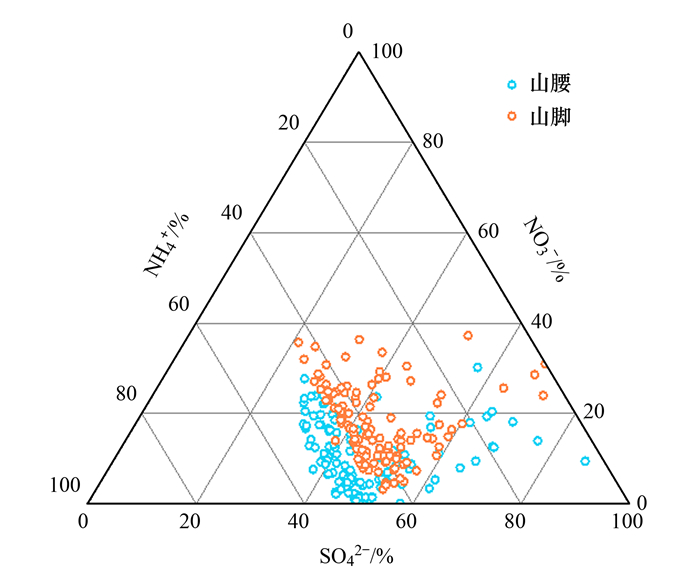
|
图 4 华山山腰及山脚PM2.5中SO42-、NO3-和NH4+组成三角分布 Fig. 4 Ternary diagram for the equivalent ratio of SO42--NO3--NH4+ in PM2.5 on the mountainside and at the foot side of Mt. Huashan |
表 2对比了华山与国内外其他高山地区PM2.5或PM2.1中的SNA浓度等参数.华山PM2.5的SNA浓度均高于美国[31]、芬兰[32]、瑞士[33]、日本[19]等国的高山地区, 也高于我国南方的黄山[29]、武夷山[20]和衡山[34], 但明显低于污染较重的泰山[30].相比南方庐山[28], 华山地区PM2.5中的SO42-和NH4+浓度更低, 但是其NO3-浓度相对高很多, 这是因为华山紧邻关中盆地, 受交通及燃煤等人为排放的NOx影响更大.另外表 2还对各个高山地区的NH4+与SO42-+NO3-的当量比进行了比较, 从中可以看出:华山的NH4+与SO42-+NO3-的当量比明显高于欧美的高山地区. Liu等[35]的研究表明中国对氮肥的大量使用导致NH3的高排放, 使得大气PM2.5中NH4+的浓度和占比高于欧美地区. 表 2还显示:华山的NH4+与SO42-+NO3-的当量比与日本及国内的高山地区大致处于同一水平.
|
|
表 2 华山与国内外其它山区颗粒物中SO42-、NO3-、NH4+的浓度比较 Table 2 Comparison of the concentrations of SO42-, NO3-, and NH4+ in particles at the mountain sites in China and other countries/μg·m-3 |
2.3 PM2.5及其无机离子的日变化特征
华山山腰及山脚气象参数及化学组成的昼夜变化如表 3所示.山腰PM2.5明显白天污染重于夜间, 而山脚正好相反.进一步分析9月12~17日污染期间两地PM2.5质量浓度的变化趋势(图 2), 发现山腰及山脚近地面地区PM2.5的质量浓度变化出现较为明显的昼夜差异.由于该时期风速降低, 气象条件趋于稳定, 地表PM2.5持续累积, 形成重霾污染, 因此其昼夜变化趋势消失.而山腰昼夜差异在9月12~17日反而更加明显[图 2(c)], 主要是因为华山地区白天温度升高, 边界层迅速抬升超过山腰高度, 加之白天山上大气受谷风主导, 高山地区气溶胶主要来自于地面污染物的传输, 因此PM2.5浓度与地表相接近, 浓度较高; 反之, 夜晚边界层降低, 山腰采样点位于边界层上层, PM2.5浓度与之前非污染期夜间浓度相当.运用NOAA(美国国家海洋和大气管理局)的READY存档气象在线计算程序(http://ready.arl.noaa.gov/READYamet.php), 按照每3 h 1次的频率计算了采样期间华山地区大气边界高度变化的时间序列[37].经分析发现:山腰点边界层高度随时间变化而变化, 高值出现在下午14:00左右, 采样期间白天边界层高度的均值在1 500 m左右, 夜间在400~500 m范围内, 表明:山腰采样点白天处于边界层内, 夜间则在边界层外.
|
|
表 3 华山山腰及山脚气象参数及化学组成昼夜变化 Table 3 Diurnal variations in meteorological parameters and chemical components on the mountainside and at the foot of Mt. Huashan |
结合图 5(a)和5(c)的离子质量浓度日变化, 发现山腰离子浓度存在很明显的昼夜变化, 白天浓度高于晚上, 峰值出现在白天12:00~16:00, 这是由于山腰采样点地处山谷地区, 存在较强的对流作用, 白天谷风明显, 地表污染物随着边界层抬升, 向山上传输所致.与此相对照, 山脚点存在两个峰值, 分别为白天08:00~12:00, 夜间00:00~04:00.白天的峰值可以看出主要是由于NO3-浓度的升高造成的, 这与车辆交通早高峰有关, 而夜间峰值除了边界层降低导致污染物升高之外, 也和夜间大型载货卡车流量显著增加带来的尾气排放增多有关. Ren等[38]的观测显示:由于夜间大型载货卡车尾气排放更多黑碳[39], 导致OC/EC比值夜间(3.1±1.1)显著低于白天(4.1±0.9).
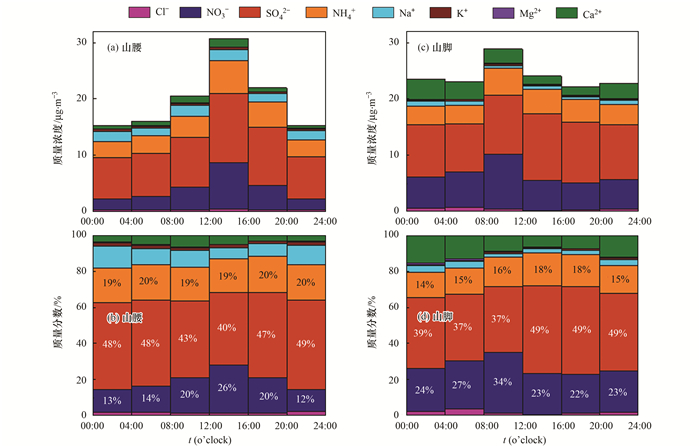
|
图 5 华山山腰及山脚无机离子质量浓度及所占质量分数日变化 Fig. 5 Diurnal variations in mass concentrations and percentages of inorganic ions on the mountainside and at the foot of Mt. Huashan |
由图 5(b)和5(d)可知, 山腰SO42-占总离子的比重存在较为明显的日变化趋势, 夜间占比较白天高, 这是因为夜间低温、高湿的气象条件更有利于SO42-的生成[2].另外, 山脚Ca2+夜间的相对贡献远高于白天, 这是因为采样期间, 夜间车速较快的大型卡车增多, 且建筑等施工活动频繁, 地表扬尘排放增强, 所以夜间的Ca2+相对贡献在00:00~04:00达到峰值.
2.4 无机离子赋存形态及来源离子间的相关性分析可以揭示气溶胶中离子的赋存形态和来源[40].华山山腰及山脚不同离子之间的相关系数如表 4所示.由于SO42-、NO3-与NH4+均来自于二次转化生成, 三者的相关性在两地都很强(相关系数>0.88).且根据NH4+与SO42-的性质可以得知这两种离子可通过NH4HSO4和(NH4)2SO4两种形式存在, 而NH4+与NO3-则以NH4NO3形式存在.当SO42-与NH4+主要以NH4HSO4的形式存在时, 颗粒物中NH4+的浓度可通过式(2)直接计算得出; 而以(NH4)2SO4的形式存在时, 颗粒物中NH4+的浓度可通过式(3)直接计算得出[41, 42]:

|
(2) |

|
(3) |
|
|
表 4 华山山腰及山脚无机离子相关性分析1) Table 4 Correlation analysis of inorganic ions on the mountainside and at the foot side of Mt Huashan |
计算所得NH4+浓度与实测数据的相关性如图 6所示, 拟合的斜率表明单一以NH4HSO4或(NH4)2SO4的存在形式计算NH4+浓度均存在较为明显的偏差, 因此NH4+是以NH4HSO4和(NH4)2SO4两种形式共存.此外图 6(c)较图 6(a)的拟合斜率更接近于1, 表明华山山腰NH4+与SO42-的存在形式主要是(NH4)2SO4; 反之图 6(b)和6(d)的对比表明山脚NH4+与SO42-的主要存在形式则为NH4HSO4.运用上述方法对山腰点样品按照清洁期和污染期分类, 进一步开展离子赋存形态分析, 从图 7(a)和7(b)的斜率可以看出:山腰点清洁期NH4+与SO42-几乎完全以(NH4)2SO4形式存在, 而在污染期则NH4HSO4和(NH4)2SO4以两种形态同时存在[图 7(c)和7(d)].

|
图 6 两种方法下华山山腰及山脚的NH4+实测浓度与理论计算浓度对比 Fig. 6 Comparison of the measured and theoretically calculated concentrations of NH4+ on the mountainside and at the foot of Mt. Huashan |
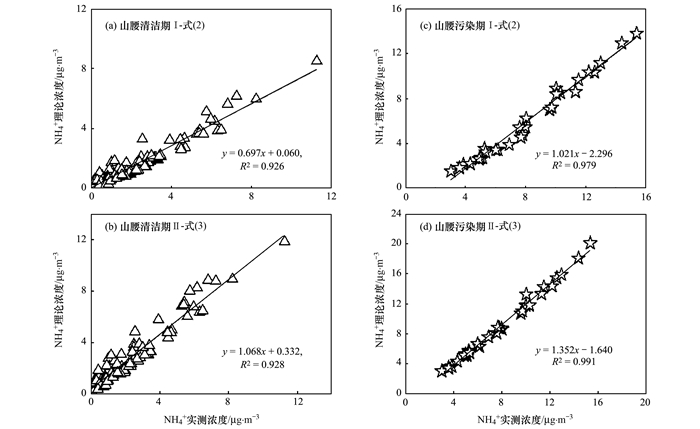
|
图 7 两种方法下华山山腰清洁期及污染期的NH4+实测浓度与理论计算浓度对比 Fig. 7 Comparison of the measured and theoretically calculated concentrations of NH4+ during the clean and polluted period on the mountainside of Mt. Huashan |
PM2.5中Ca2+和Mg2+浓度主要来自地表矿物粉尘[7, 43], 因此两个点位Ca2+和Mg2+也存在较强的相关性(0.72和0.78).此外, 山腰K+与Cl-存在较好的相关性(0.75)(表 4). K+和Cl-均可由生物质燃烧和海盐的排放产生[43, 44], 但华山地处内陆地区, 基本不受海盐离子的影响, 因此高山地区K+和Cl-主要来源于生物质燃烧的排放.而山脚地区K+与Cl-相关性较差, 说明其来源更加复杂, 可能还与地表粉尘和燃煤排放等因素有关.
2.5 PM2.5酸碱性分析离子平衡计算可被用来估计气溶胶的酸碱平衡, 其中阴离子电荷当量计算公式AE(anion equivalent)和阳离子电荷当量计算公式CE(cation equivalent)如式(4)和式(5)所示(ρ表示该离子的质量浓度):

|
(4) |

|
(5) |
图 8所示为两地阴、阳离子电荷当量的相关关系, 其相关系数均高于0.92.山腰及山脚的线性回归线斜率(阳离子/阴离子)均低于1(~0.8), 表明气溶胶颗粒呈酸性特征[45].比较图 8(a)和8(b)的斜率可知, 山腰的斜率<山脚的斜率, 表明山脚的气溶胶酸性略强于山腰. Li等[29]对黄山不同高度的PM2.1样品进行当量平衡分析, 其结果是低海拔比高海拔更酸, 说明华山与黄山的细颗粒物在不同海拔的酸度差异相类似.本研究运用热力学模型ISORROPIAⅡ对两个站点PM2.5酸度进行定量计算, 结果显示:华山山腰及山脚的pH值分别为3.2±2.3和2.9±2.0(表 1), 与阴阳离子当量平衡计算的结论一致, 进一步表明华山地区近地面大气气溶胶的酸性更强.
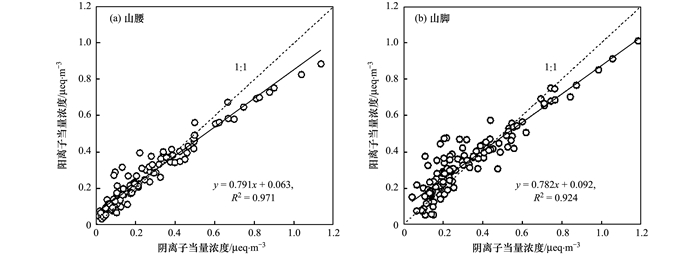
|
图 8 华山山腰及山脚PM2.5中阴阳离子平衡 Fig. 8 Equivalent ratios of cations to anions in PM2.5 on the mountainside and at the foot of Mt. Huashan |
(1) 2016年夏季华山地区山腰及山脚大气PM2.5的浓度水平分别为(46.9±38.2) μg·m-3和(76.0±44.3) μg·m-3, PM2.5中SO42-、NO3-和NH4+浓度分别占总离子的48%、20%、21%(山腰)和43%、26%、16%(山脚).
(2) PM2.5中各离子浓度呈现出山腰浓度低于山脚的垂直分布特征, 其中山脚NO3-和Ca2+分别是山腰的1.6倍和2.8倍, 这主要是华山山脚受人为污染影响更显著, 尤其是机动车的影响, 机动车不仅会造成NO3-前体物, 即氮氧化物排放的增多, 还会造成更多的扬尘, 从而导致NO3-和Ca2+的浓度远高于山腰.
(3) 华山山腰PM2.5中离子浓度白天远高于夜间, 且在12:00~16:00达到峰值, 这主要因为白天受山谷风影响以及边界层抬升, 使得地表污染物被输送到山腰的缘故; 而山脚PM2.5中离子浓度分别在白天08:00~12:00和夜间00:00~04:00出现峰值, 这是因为上午交通流量大幅增高导致机动车尾气排放增加以及夜间边界层降低带来的污染物累积效应所致, 此外, 夜间地表大型载货卡车流量增高带来的污染物排放增加也是重要因素之一.
(4) 无机离子赋存形态分析表明:华山山腰SNA存在形式主要是(NH4)2SO4和NH4NO3, 而山脚SNA的存在形式主要是NH4HSO4和NH4NO3.当量平衡和热力学模型计算均表明:华山地表PM2.5比山腰酸度更强.
| [1] | Zhang R Y, Wang G H, Guo S, et al. Formation of urban fine particulate matter[J]. Chemical Reviews, 2015, 115(10): 3803-3855. DOI:10.1021/acs.chemrev.5b00067 |
| [2] | Wang G H, Zhang R Y, Gomez M E, et al. Persistent sulfate formation from London Fog to Chinese haze[J]. Proceedings of the National Academy of Sciences of the United States of America, 2016, 113(48): 13630-13635. DOI:10.1073/pnas.1616540113 |
| [3] | Tian M, Wang H B, Chen Y, et al. Highly time-resolved characterization of water-soluble inorganic ions in PM2.5 in a humid and acidic mega city in Sichuan Basin, China[J]. Science of The Total Environment, 2017, 580: 224-234. DOI:10.1016/j.scitotenv.2016.12.048 |
| [4] | He Q S, Yan Y L, Guo L L, et al. Characterization and source analysis of water-soluble inorganic ionic species in PM2.5 in Taiyuan city, China[J]. Atmospheric Research, 2017, 184: 48-55. DOI:10.1016/j.atmosres.2016.10.008 |
| [5] | Galindo N, Yubero E, Nicolás J F, et al. Regional and long-range transport of aerosols at Mt. Aitana, Southeastern Spain[J]. Science of The Total Environment, 2017, 584-585: 723-730. DOI:10.1016/j.scitotenv.2017.01.108 |
| [6] | Zhang T, Cao J J, Tie X X, et al. Water-soluble ions in atmospheric aerosols measured in Xi'an, China:Seasonal variations and sources[J]. Atmospheric Research, 2011, 102(1-2): 110-119. DOI:10.1016/j.atmosres.2011.06.014 |
| [7] | Wang P, Cao J J, Shen Z X, et al. Spatial and seasonal variations of PM2.5 mass and species during 2010 in Xi'an, China[J]. Science of The Total Environment, 2015, 508: 477-487. DOI:10.1016/j.scitotenv.2014.11.007 |
| [8] | Saxena M, Sharma A, Sen A, et al. Water soluble inorganic species of PM10 and PM2.5 at an urban site of Delhi, India:Seasonal variability and sources[J]. Atmospheric Research, 2017, 184: 112-125. DOI:10.1016/j.atmosres.2016.10.005 |
| [9] | Bian Q, Huang X H H, Yu J Z. One-year observations of size distribution characteristics of major aerosol constituents at a coastal receptor site in Hong Kong-Part 1:Inorganic ions and oxalate[J]. Atmospheric Chemistry and Physics, 2014, 14(17): 9013-9027. DOI:10.5194/acp-14-9013-2014 |
| [10] | Li X R, Wang L L, Ji D S, et al. Characterization of the size-segregated water-soluble inorganic ions in the Jing-Jin-Ji urban agglomeration:Spatial/temporal variability, size distribution and sources[J]. Atmospheric Environment, 2013, 77: 250-259. DOI:10.1016/j.atmosenv.2013.03.042 |
| [11] | Guo S, Hu M, Wang Z B, et al. Size-resolved aerosol water-soluble ionic compositions in the summer of Beijing:implication of regional secondary formation[J]. Atmospheric Chemistry and Physics, 2010, 10(3): 947-959. DOI:10.5194/acp-10-947-2010 |
| [12] | Agarwal S, Aggarwal S G, Okuzawa K, et al. Size distributions of dicarboxylic acids, ketoacids, α-dicarbonyls, sugars, WSOC, OC, EC and inorganic ions in atmospheric particles over Northern Japan:implication for long-range transport of Siberian biomass burning and East Asian polluted aerosols[J]. Atmospheric Chemistry and Physics, 2010, 10(13): 5839-5858. DOI:10.5194/acp-10-5839-2010 |
| [13] | Hu G Y, Zhang Y M, Sun J Y, et al. Variability, formation and acidity of water-soluble ions in PM2.5 in Beijing based on the semi-continuous observations[J]. Atmospheric Research, 2014, 145-146: 1-11. DOI:10.1016/j.atmosres.2014.03.014 |
| [14] | Fu X X, Guo H, Wang X M, et al. PM2.5 acidity at a background site in the Pearl River Delta region in fall-winter of 2007-2012[J]. Journal of Hazardous Materials, 2015, 286: 484-492. DOI:10.1016/j.jhazmat.2015.01.022 |
| [15] | Guo H Y, Sullivan A P, Campuzano-Jost P, et al. Fine particle pH and the partitioning of nitric acid during winter in the northeastern United States[J]. Journal of Geophysical Research:Atmospheres, 2016, 121(17): 10355-10376. DOI:10.1002/jgrd.v121.17 |
| [16] | Wang G, Li J, Cheng C, et al. Observation of atmospheric aerosols at Mt. Hua and Mt. Tai in central and east China during spring 2009-Part 1:EC, OC and inorganic ions[J]. Atmospheric Chemistry and Physics, 2011, 11(9): 4221-4235. DOI:10.5194/acp-11-4221-2011 |
| [17] | Andreae M O, Rosenfeld D. Aerosol-cloud-precipitation interactions. Part 1. The nature and sources of cloud-active aerosols[J]. Earth-Science Reviews, 2008, 89(1-2): 13-41. DOI:10.1016/j.earscirev.2008.03.001 |
| [18] | Rosenfeld D, Dai J, Yu X, et al. Inverse relations between amounts of air pollution and orographic precipitation[J]. Science, 2007, 315(5817): 1396-1398. DOI:10.1126/science.1137949 |
| [19] |
李建军. 关中平原高山气溶胶化学组成、粒径分布及源解析[D]. 西安: 西安交通大学, 2011. 1-122. Li J J. Chemical composition, size distribution and source apportionment of atmospheric aerosols at an Alpine Site in Guanzhong Plain, China[D]. Xi'an: Xi'an Jiaotong University, 2011. 1-122. |
| [20] |
苏彬彬, 张智胜, 陶俊, 等. 春季华东高山背景区域PM2.5和PM2.5~10中水溶性无机离子特征[J]. 环境科学, 2015, 36(4): 1195-1201. Su B B, Zhang Z S, Tao J, et al. Characteristics of water-soluble inorganic ions in PM2.5 and PM2.5-10 in mountain background region of east China in spring[J]. Environmental Science, 2015, 36(4): 1195-1201. |
| [21] |
文彬, 银燕, 秦彦硕, 等. 夏季黄山不同高度大气气溶胶水溶性离子特征分析[J]. 环境科学, 2013, 34(5): 1973-1981. Wen B, Yin Y, Qin Y S, et al. Chemical characteristics of water-soluble components of aerosol particles at different altitudes of the Mount Huang in the summer[J]. Environmental Science, 2013, 34(5): 1973-1981. |
| [22] |
陈辰, 高志球, 徐惟琦, 等. APEC前后北京SO2垂直分布特征及其对二次硫酸盐生成的影响[J]. 环境科学学报, 2016, 36(6): 2131-2141. Chen C, Gao Z Q, Xu W Q, et al. Vertical distribution of SO2 and its impact on the formation of secondary sulfate in urban Beijing during 2014 APEC summit[J]. Acta Scientiae Circumstantiae, 2016, 36(6): 2131-2141. |
| [23] | Cao J J, Lee S C, Chow J C, et al. Spatial and seasonal distributions of carbonaceous aerosols over China[J]. Journal of Geophysical Research:Atmospheres, 2007, 112(D22): D22S11. |
| [24] | Li J J, Wang G H, Zhou B H, et al. Chemical composition and size distribution of wintertime aerosols in the atmosphere of Mt. Hua in central China[J]. Atmospheric Environment,, 2011, 45(6): 1251-1258. DOI:10.1016/j.atmosenv.2010.12.009 |
| [25] | Wang G H, Zhou B H, Cheng C L, et al. Impact of Gobi desert dust on aerosol chemistry of Xi'an, inland China during spring 2009:differences in composition and size distribution between the urban ground surface and the mountain atmosphere[J]. Atmospheric Chemistry and Physics, 2013, 13(2): 819-835. DOI:10.5194/acp-13-819-2013 |
| [26] | Fountoukis C, Nenes A. ISORROPIA Ⅱ:a computationally efficient thermodynamic equilibrium model for K+-Ca2+-Mg2+-NH4+-Na+-SO42--NO3--Cl--H2O aerosols[J]. Atmospheric Chemistry and Physics Discussions, 2007, 7(1): 1893-1939. DOI:10.5194/acpd-7-1893-2007 |
| [27] | Hennigan C J, Izumi J, Sullivan A P, et al. A critical evaluation of proxy methods used to estimate the acidity of atmospheric particles[J]. Atmospheric Chemistry and Physics, 2015, 15(5): 2775-2790. DOI:10.5194/acp-15-2775-2015 |
| [28] | Li W J, Chi J W, Shi Z B, et al. Composition and hygroscopicity of aerosol particles at Mt. Lu in South China:Implications for acid precipitation[J]. Atmospheric Environment, 2014, 94: 626-636. DOI:10.1016/j.atmosenv.2014.06.003 |
| [29] | Li L, Yin Y, Kong S F, et al. Altitudinal effect to the size distribution of water soluble inorganic ions in PM at Huangshan, China[J]. Atmospheric Environment, 2014, 98: 242-252. DOI:10.1016/j.atmosenv.2014.08.077 |
| [30] | Zhou Y, Wang T, Gao X M, et al. Continuous observations of water-soluble ions in PM2.5 at Mount Tai (1534 m a.s.l.) in central-eastern China[J]. Journal of Atmospheric Chemistry, 2009, 64(2-3): 107-127. DOI:10.1007/s10874-010-9172-z |
| [31] | Lee T, Yu X Y, Kreidenweis S M, et al. Semi-continuous measurement of PM2.5 ionic composition at several rural locations in the United States[J]. Atmospheric Environment, 2008, 42(27): 6655-6669. DOI:10.1016/j.atmosenv.2008.04.023 |
| [32] | Teinilä K, Hillamo R, Kerminen V-M, et al. Chemistry and modal parameters of major ionic aerosol components during the NICE campaigns at two altitudes[J]. Atmospheric Environment, 2004, 38(10): 1481-1490. DOI:10.1016/j.atmosenv.2003.11.028 |
| [33] | Krivácsy Z, Hoffer A, Sárvári Z, et al. Role of organic and black carbon in the chemical composition of atmospheric aerosol at European background sites[J]. Atmospheric Environment, 2001, 35(36): 6231-6244. DOI:10.1016/S1352-2310(01)00467-8 |
| [34] | Gao X M, Xue L K, Wang X F, et al. Aerosol ionic components at Mt. Heng in central southern China:Abundances, size distribution, and impacts of long-range transport[J]. Science of The Total Environment, 2012, 433: 498-506. DOI:10.1016/j.scitotenv.2012.06.095 |
| [35] | Liu X J, Zhang Y, Han W X, et al. Enhanced nitrogen deposition over China[J]. Nature, 2013, 494(7438): 459-462. DOI:10.1038/nature11917 |
| [36] | Kido M, Osada K, Matsunaga K, et al. Diurnal variation of ionic aerosol species and water-soluble gas concentrations at a high-elevation site in the Japanese Alps[J]. Journal of Geophysical Research:Atmospheres, 2001, 106(D15): 17335-17345. DOI:10.1029/2000JD900775 |
| [37] | Kong S F, Li L, Li X X, et al. The impacts of firework burning at the Chinese Spring Festival on air quality:insights of tracers, source evolution and aging processes[J]. Atmospheric Chemistry and Physics, 2015, 15(4): 2167-2184. DOI:10.5194/acp-15-2167-2015 |
| [38] | Ren Y, Zhou B, Tao J, et al. Composition and size distribution of airborne particulate PAHs and oxygenated PAHs in two Chinese megacities[J]. Atmospheric Research, 2017, 183: 322-330. DOI:10.1016/j.atmosres.2016.09.015 |
| [39] | Ban-Weiss G A, Lunden M M, Kirchstetter T W, et al. Measurement of black carbon and particle number emission factors from individual heavy-duty trucks[J]. Environmental science & technology, 2009, 43(5): 1419-1424. |
| [40] |
沈振兴, 李丽珍, 杜娜, 等. 西安市春季大气细粒子的质量浓度及其水溶性组分的特征[J]. 生态环境, 2007, 16(4): 1193-1198. Shen Z X, Li L Z, Du N, et al. Mass concentration and water-soluble ions in spring aerosol (PM2.5) at Xi'an[J]. Ecology and Environment, 2007, 16(4): 1993-1998. |
| [41] | Shen Z, Arimoto R, Cao J, et al. Seasonal variations and evidence for the effectiveness of pollution controls on water-soluble inorganic species in total suspended particulates and fine particulate matter from Xi'an, China[J]. Journal of the Air & Waste Management Association, 2008, 58(12): 1560-1570. |
| [42] | Kang C M, Lee H S, Kang B W, et al. Chemical characteristics of acidic gas pollutants and PM2.5 species during hazy episodes in Seoul, South Korea[J]. Atmospheric Environment, 2004, 38(28): 4749-4760. DOI:10.1016/j.atmosenv.2004.05.007 |
| [43] |
张凯, 王跃思, 温天雪, 等. 北京大气PM10中水溶性金属盐的在线观测与浓度特征研究[J]. 环境科学, 2008, 29(1): 246-252. Zhang K, Wang Y S, Wen T X, et al. On-line analysis and mass concentration characters of the alkali metal ions of PM10 in Beijing[J]. Environmental Science, 2008, 29(1): 246-252. |
| [44] | Andreae M O. Soot carbon and excess fine potassium:long-range transport of combustion-derived aerosols[J]. Science, 1983, 220(4602): 1148-1151. DOI:10.1126/science.220.4602.1148 |
| [45] | Kerminen V M, Hillamo R, Teinilä K, et al. Ion balances of size-resolved tropospheric aerosol samples:implications for the acidity and atmospheric processing of aerosols[J]. Atmospheric Environment, 2001, 35(31): 5255-5265. DOI:10.1016/S1352-2310(01)00345-4 |
 2018, Vol. 39
2018, Vol. 39


